A Diagnostic Analysis of the 2024 Beijing May 30 Gale Simulation Based on Satellite Observation Products
Abstract
1. Introduction
2. Materials and Methods
2.1. Case Study
- (1)
- Widespread impact and strong intensity of the wind. A gale with a wind speed of force 13 (37.2 m s−1 at Qianling Mountain station) was observed in Beijing;
- (2)
- Rapid convective development, a high wind speed, and fast-moving cloud systems. The system rapidly developed and moved eastward near Zhangjiakou City in Hebei Province around noon, with the linear convective system advancing at a speed of 70 km h−1;
2.2. Research Principles
2.3. FY-4B L2 Products
2.4. Simulation Configuration of the CMA-MESO
2.5. Data Processing for Diagnostic Analysis
3. Results and Analysis
3.1. Specific Design of the Diagnostic Scheme
- (1)
- An overall analysis. Based on the FY-4B L2 products, an overall analysis is firstly conducted on the physical processes during the development of this gale.
- (2)
- Spatial diagnostic analysis. The FY-4B L2 products in the diagnostic dataset for the Beijing region are used for diagnostic analysis of the CMA-MESO simulations, so as to gain a comprehensive understanding of the impact range of the gale and the model’s performance in spatial simulation.
- (3)
- Station diagnostic analysis. This analysis is conducted by using the station-based diagnostic dataset from the 14 typical impacted stations, focusing on NSR, LST, CFR, CTH, AQ_Prof, and AT_Prof.
- (4)
- Comprehensive analysis results integration. The spatiotemporal variations in the diagnostic analysis results for radiative energy, LST, cloud-related variables, AQ_Prof, and AT_Prof are obtained.
3.2. An Overall Analysis by the Observations from FY-4B AGRI
3.3. Spatial Diagnostic Analysis
3.3.1. Diagnostic Analyses of Shortwave Radiation, Land Surface Temperature, and Cloud Coverage
3.3.2. Diagnostic Analysis of the Thermal Field
3.4. Station Diagnostic Analysis
3.4.1. Overall Diagnostic Analysis of Surface Net Shortwave Radiation, Land Surface Temperature, and Cloud Top Height
3.4.2. Specific Diagnostic Analysis of Surface Net Shortwave Radiation, Land Surface Temperature, Cloud Coverage, and Cloud Top Height
3.4.3. Specific Diagnostic Analysis of Temperature and Humidity Profiles
4. Conclusions and Discussion
Author Contributions
Funding
Data Availability Statement
Acknowledgments
Conflicts of Interest
References
- Kelly, D.L.; Schaefer, J.T.; Doswell, C.A. Climatology of nontornadic severe thunderstorm events in the United States. Mon. Weather Rev. 1985, 113, 1997–2014. [Google Scholar] [CrossRef]
- Fujita, T. Precipitation and cold air production in mesoscale thunderstorm systems. J. Atmos. Sci. 1959, 16, 454–466. [Google Scholar] [CrossRef]
- Doswell, C.A., III. The distinction between large-scale and mesoscale contribution to severe convection: A case study example. Weather Forecast. 1987, 2, 3–16. [Google Scholar] [CrossRef]
- Tao, S.Y. Rainstorms in China; Science Press: Beijing, China, 1980. [Google Scholar]
- Ding, Y.H. Advanced Synoptic Meteorology, 2nd ed.; China Meteorological Press: Beijing, China, 2005. [Google Scholar]
- Fang, C.; Wang, X.G.; Sheng, J.; Cao, Y.C. Temporal and Spatial Distribution of North China Thunder-gust Winds and the Statistical Analysis of Physical Characteristics. Plateau Meteorol. 2017, 36, 1368–1385. [Google Scholar]
- Doswell, C.A., III. Severe convective storms—An overview. Sev. Convect. Storms 2001, 28, 1–26. [Google Scholar] [CrossRef]
- Doswell, C.A., III. Historical overview of severe convective storms research. E-J. Sev. Storms Meteorol. 2007, 2, 1–25. [Google Scholar] [CrossRef]
- Anthes, R.A. Numerical prediction of severe storms—Certainty, possibility, or dream? Bull. Am. Meteorol. Soc. 1976, 57, 423–430. [Google Scholar]
- Wan, Z.W.; Sun, S.Y.; Zhao, B.; Chen, Q.Y. Evaluation and Error Analysis of the July 2021 Extremely Severe Rainstorm in Henan Province Simulated by CMA-MESO Mode. Meteorol. Mon. 2024, 50, 33–47. [Google Scholar] [CrossRef]
- Yang, J.; Quan, W.; Zhang, L.; Hu, J.; Chen, Q.; Wild, M. Evaluation of radiation schemes in the CMA-MESO model using high time-resolution radiation measurements in China: I. Long-wave radiation. Geosci. Model Dev. Discuss. 2024, 2024, 1–29. [Google Scholar] [CrossRef]
- Zhang, R.; Fu, W.; Wang, L.; Xu, Y. Influence of Different Radiation Schemes on Strong Convective Weather Processes. In Proceedings of the 2007 Annual Meeting of the Chinese Meteorological Society, Guangzhou, China, 23–25 November 2007. [Google Scholar]
- Zhang, L.X.; Li, Z.C. Numerical Analysis of Solar Shortwave Radiation Affecting Severe Convection in Cold Vortex over Northeastern China. Meteorol. Mon. 2008, 34, 3–10. [Google Scholar]
- Zheng, L.L.; Zhang, X.G.; Qiu, X.X.; Zheng, L.L.; Zhang, S.L.; Qiu, X.X.; Tao, W.; Wang, Y.; Shao, L.Y.; Xie, F.; et al. Impacts of the Dabie Mountains on a Mesoscale Convective System that Occurred in the Background of the Northeast Cold Vortex. Chin. J. Atmos. Sci. 2023, 47, 2001–2019. [Google Scholar] [CrossRef]
- Wild, M. Global dimming and brightening: A review. J. Geophys. Res. Atmos. 2009, 114, D00D16. [Google Scholar] [CrossRef]
- Tang, W.; Yang, K.; He, J.; Qin, J. Quality control and estimation of global solar radiation in China. Sol. Energy 2010, 84, 466–475. [Google Scholar] [CrossRef]
- Tang, W.; Yang, K.; Qin, J.; Min, M. Development of a 50-year daily surface solar radiation dataset over China. Sci. China Earth Sci. 2013, 56, 1555–1565. [Google Scholar] [CrossRef]
- Letu, H.; Yang, K.; Nakajima, T.Y.; Ishimoto, H.; Nagao, T.M.; Riedi, J.; Baran, A.J.; Ma, R.; Wang, T.; Shang, H. High-resolution retrieval of cloud microphysical properties and surface solar radiation using Himawari-8/AHI next-generation geostationary satellite. Remote Sens. Environ. 2020, 239, 111583. [Google Scholar] [CrossRef]
- Tang, W.; Li, J.; Yang, K.; Qin, J.; Zhang, G.; Wang, Y. Dependence of remote sensing accuracy of global horizontal irradiance at different scales on satellite sampling frequency. Sol. Energy 2019, 193, 597–603. [Google Scholar] [CrossRef]
- Zheng, L.L.; Qian, L. Simulation Study of a Squall Line Case Based on Assimilation Radar Reflectivity Data. Meteorol. Mon. 2019, 45, 73–87. [Google Scholar] [CrossRef]
- Chen, F.; Dong, M.Y.; Su, T.; Ji, C.X. Influence of Radar Data Assimilation on the Numerical Simulation of a Rare Squall Line in Zhejiang Province in Early Spring. Meteorol. Mon. 2020, 46, 462–477. [Google Scholar]
- Lai, A.W.; Ma, H.Z.; Cui, C.G.; Kang, Z.P.; Wang, Z.B.; Du, M.Y.; Xiao, Y.J.; Wang, J. A Squall Line Case Study of Assimilating the Radar Data, Retrieval of Water Vapor and In-Cloud Potential Temperature from Reflectivity in a 3DVAR Framework. Meteorol. Mon. 2021, 47, 932–952. [Google Scholar] [CrossRef]
- Lv, M.; Hou, Z.; Zhou, Y. Dynamic Meteorology; Meteorological Press: Beijing, China, 2004. [Google Scholar]
- Heitor, A.; Biga, A.; Rosa, R. Thermal radiation components of the energy balance at the ground. Agric. For. Meteorol. 1991, 54, 29–48. [Google Scholar] [CrossRef]
- Budyko, M.I. The heat balance of the earth’s surface. Sov. Geogr. 1961, 2, 3–13. [Google Scholar] [CrossRef]
- Nullet, D.; Sanderson, M. Radiation and energy balances and air temperature. Prevail. Trade Wind. Weather Clim. Hawaii. Univ. Hawaii Press Honol. 1993, 37–55. [Google Scholar] [CrossRef]
- Stephens, G.; Campbell, G.; Haar, T.V. Earth radiation budgets. J. Geophys. Res. Ocean. 1981, 86, 9739–9760. [Google Scholar] [CrossRef]
- Cotton, W.R.; Anthes, R.A. Storm and Cloud Dynamics; Academic Press: New York, NY, USA, 1992. [Google Scholar]
- Dudhia, J. Numerical study of convection observed during the winter monsoon experiment using a mesoscale two-dimensional model. J. Atmos. Sci. 1989, 46, 3077–3107. [Google Scholar] [CrossRef]
- Wang, S.; Lu, F.; Feng, Y. An investigation of the Fengyun-4A/B GIIRS performance on temperature and humidity retrievals. Atmosphere 2022, 13, 1830. [Google Scholar] [CrossRef]
- NSMC. FY-4B L2 Products. Available online: https://data.nsmc.org.cn/DataPortal/cn/data/overview.html (accessed on 20 October 2024).
- Dehui, C.; Xueshun, S. Recent progress on GRAPES research and application. J. Appl. Meteorol. Sci. 2006, 17, 773–777. [Google Scholar]
- Chen, D.; Xue, J.; Yang, X.; Zhang, H.; Shen, X.; Hu, J.; Wang, Y.; Ji, L.; Chen, J. New generation of multi-scale NWP system (GRAPES): General scientific design. Chin. Sci. Bull. 2008, 53, 3433–3445. [Google Scholar] [CrossRef]
- Wang, Y.L.L. GRAPES_MESO Operational System Technical Report. In Proceedings of the 2007 Annual Meeting of the Chinese Meteorological Society, Weather Forecasting, Warning, and Impact Assessment Technical Session, Guangzhou, China, 23–25 November 2007. [Google Scholar]
- Huang, L.P.; Deng, L.T.; Xu, Z.F.; Yu, F.; Jiang, Y.; Zhou, F.F. Main Technical Improvements of GRAPES_Meso V4.0 and Verification. J. Appl. Meteorol. Sci. 2017, 28, 25–37. [Google Scholar] [CrossRef]
- Hong, S.-Y.; Lim, J.-O.J. The WRF single-moment 6-class microphysics scheme (WSM6). Asia-Pac. J. Atmos. Sci. 2006, 42, 129–151. [Google Scholar]
- Mlawer, E.J.; Taubman, S.J.; Brown, P.D.; Iacono, M.J.; Clough, S.A. Radiative transfer for inhomogeneous atmospheres: RRTM, a validated correlated-k model for the longwave. J. Geophys. Res. Atmos. 1997, 102, 16663–16682. [Google Scholar] [CrossRef]
- Beljaars, A.; Holtslag, A. Flux parameterization over land surfaces for atmospheric models. J. Appl. Meteorol. Climatol. 1991, 30, 327–341. [Google Scholar] [CrossRef]
- Ek, M.; Mitchell, K.; Lin, Y.; Rogers, E.; Grunmann, P.; Koren, V.; Gayno, G.; Tarpley, J. Implementation of Noah land surface model advances in the National Centers for Environmental Prediction operational mesoscale Eta model. J. Geophys. Res. Atmos. 2003, 108, 8851. [Google Scholar] [CrossRef]
- Li, Y.D.; Liu, J.W.; Gao, S.T. On the Progress of Application for Dynamic and Energetic Convective Parameters Associated with Severe Convective Weather Forecasting. Acta Meteorol. Sin. 2004, 62, 401–409. [Google Scholar] [CrossRef]
- Sun, J.S.; Tao, Z.Y. Some Essential Issues Connected with Severe Connected with Severe Convective Weather Analysis and Forecast. Meteorol. Mon. 2012, 38, 164–173. [Google Scholar]

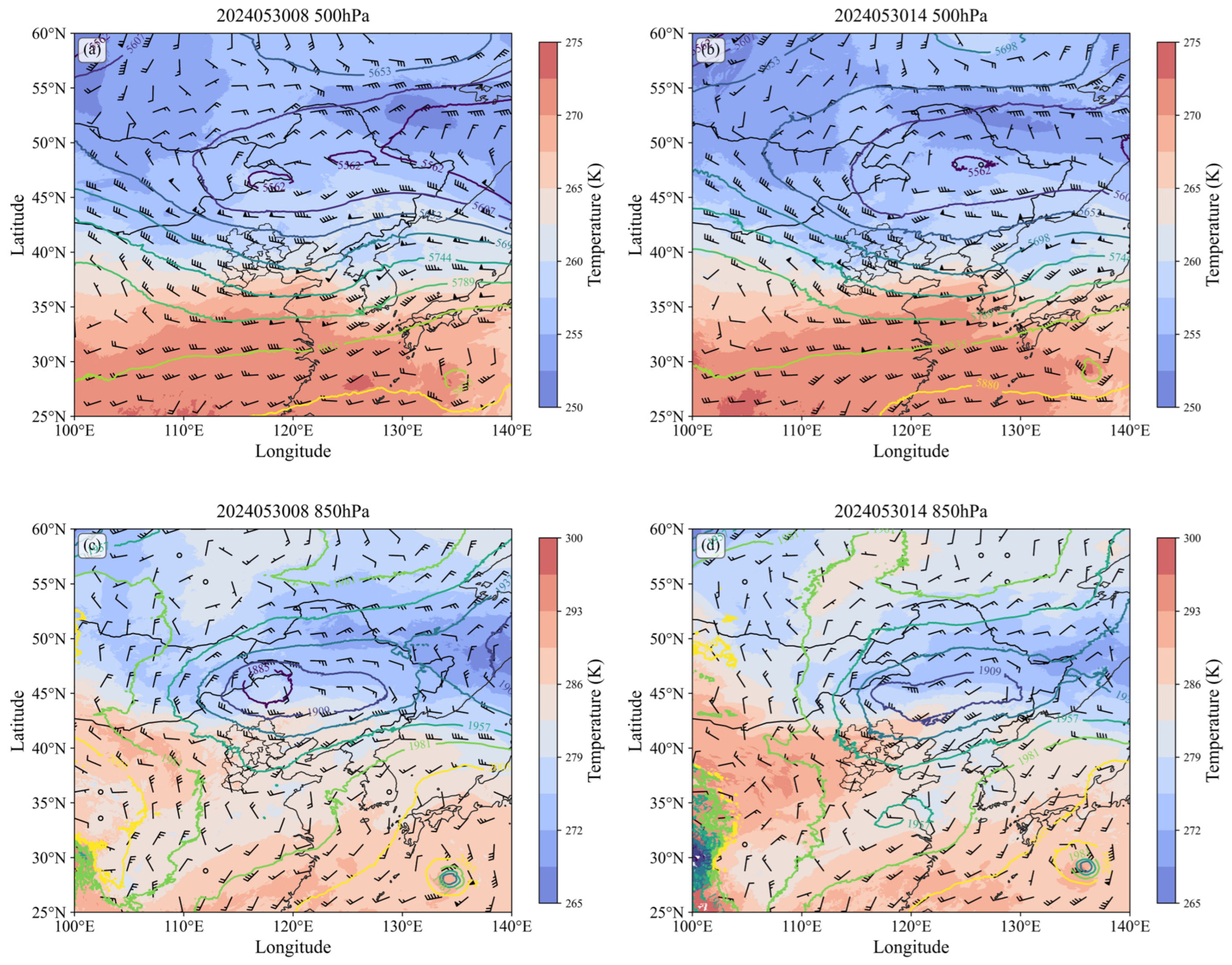

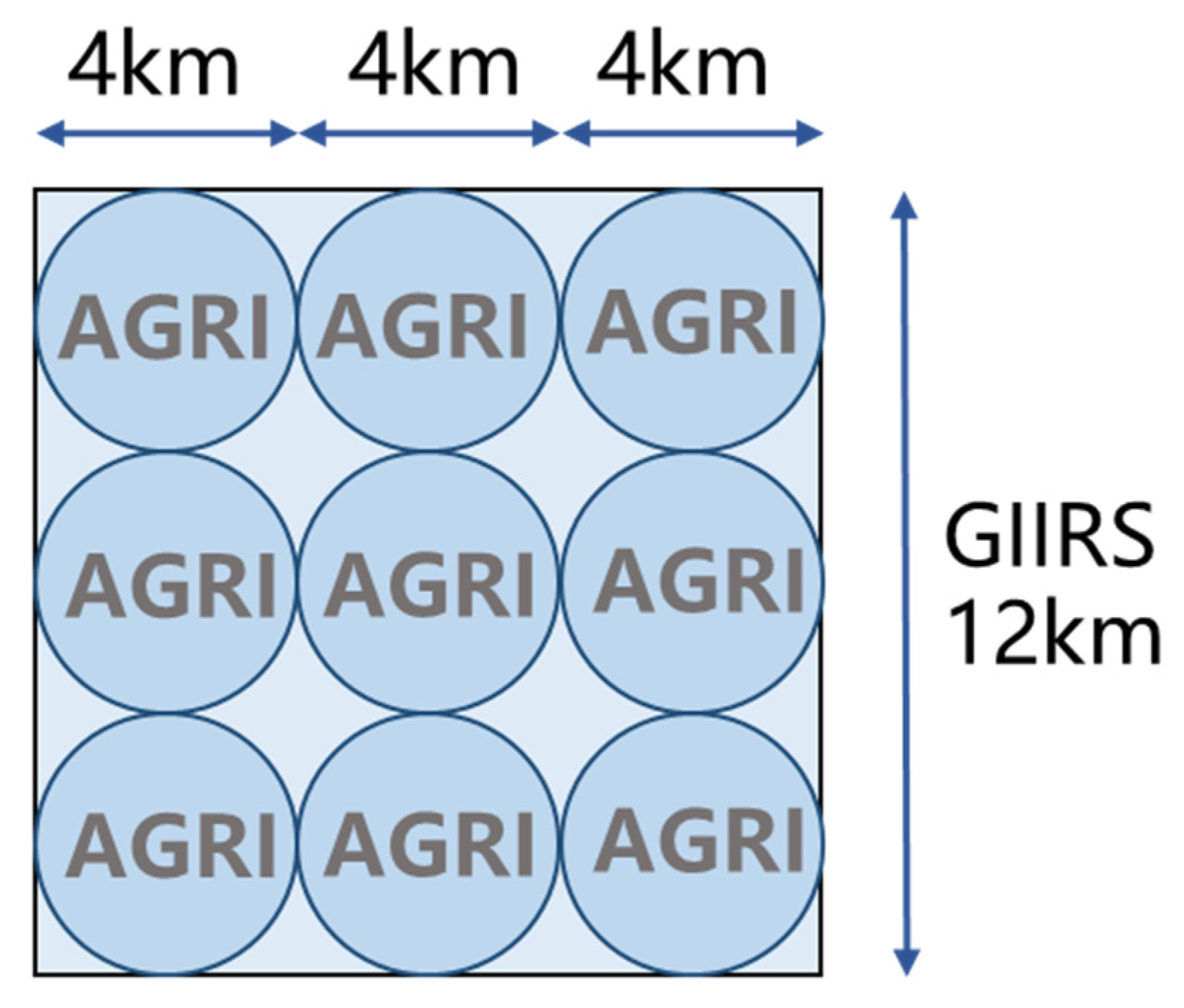

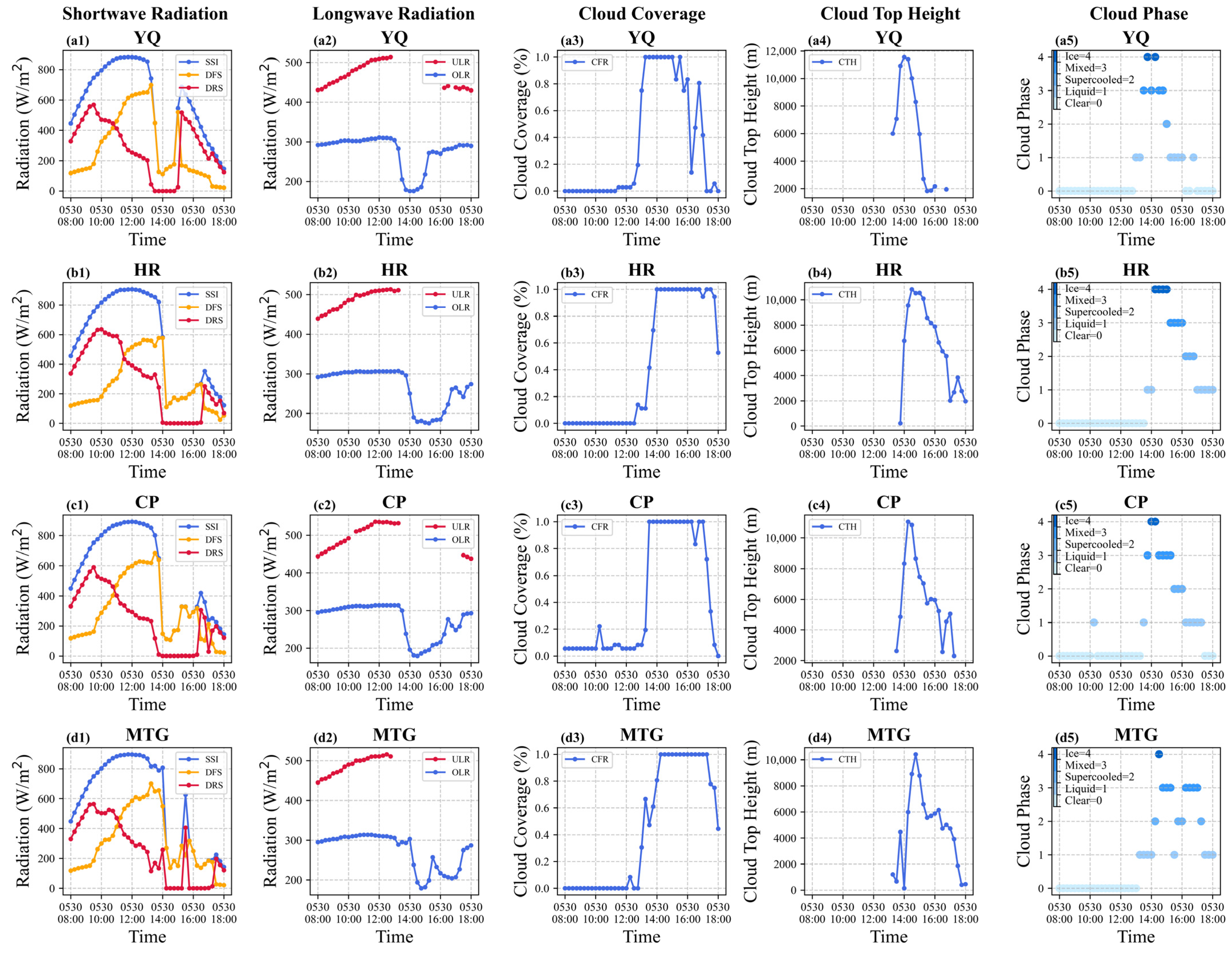
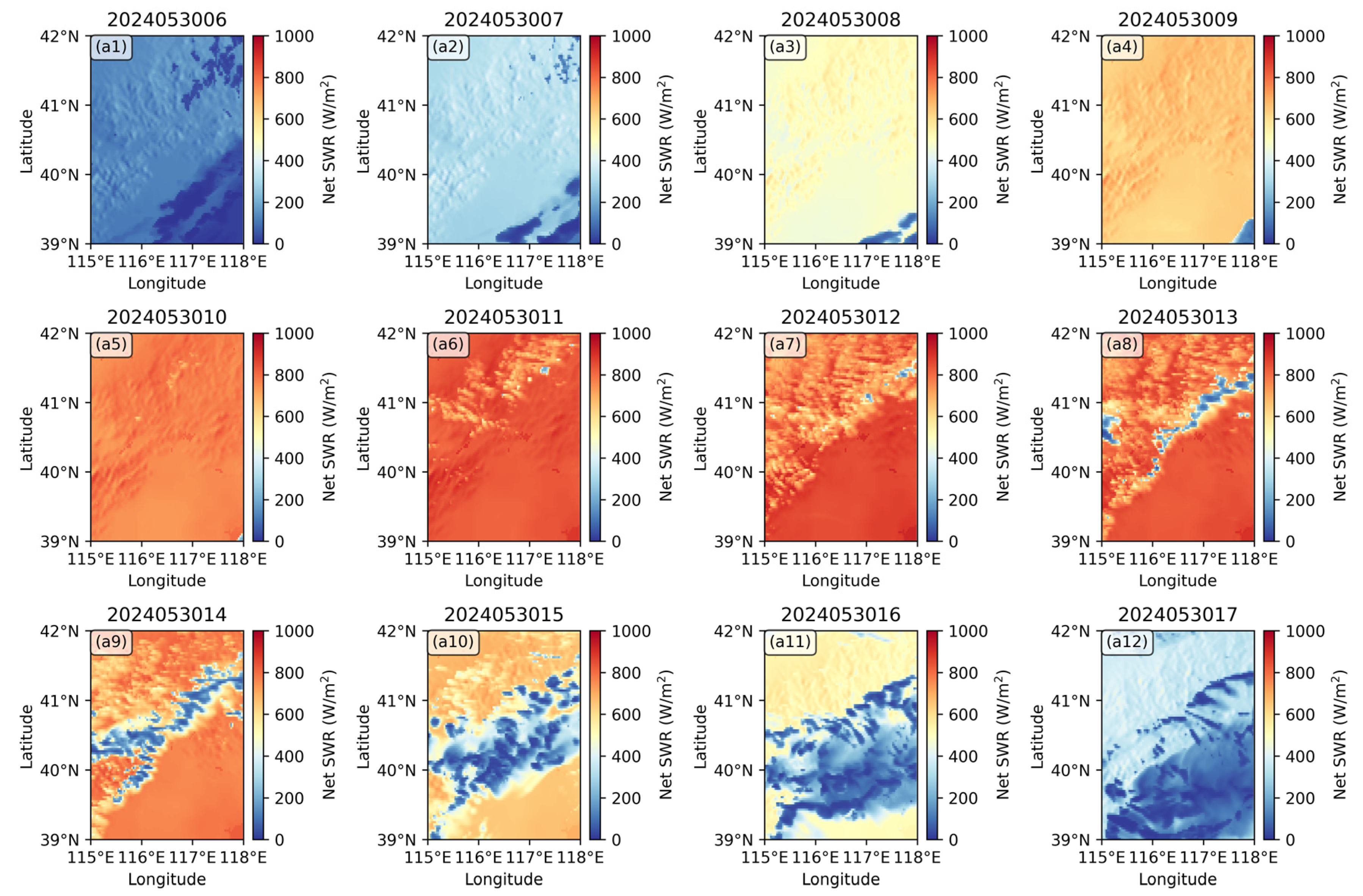
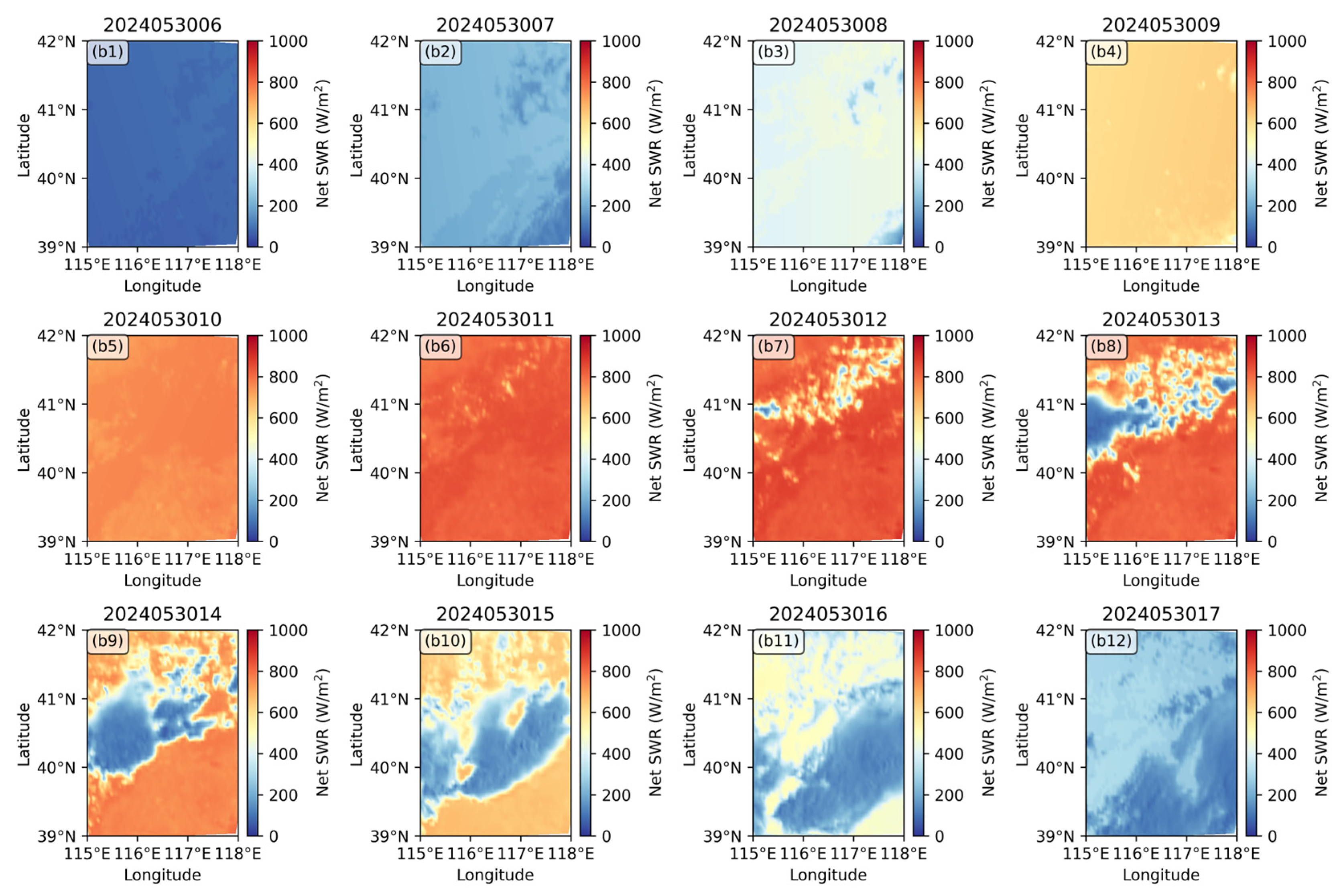
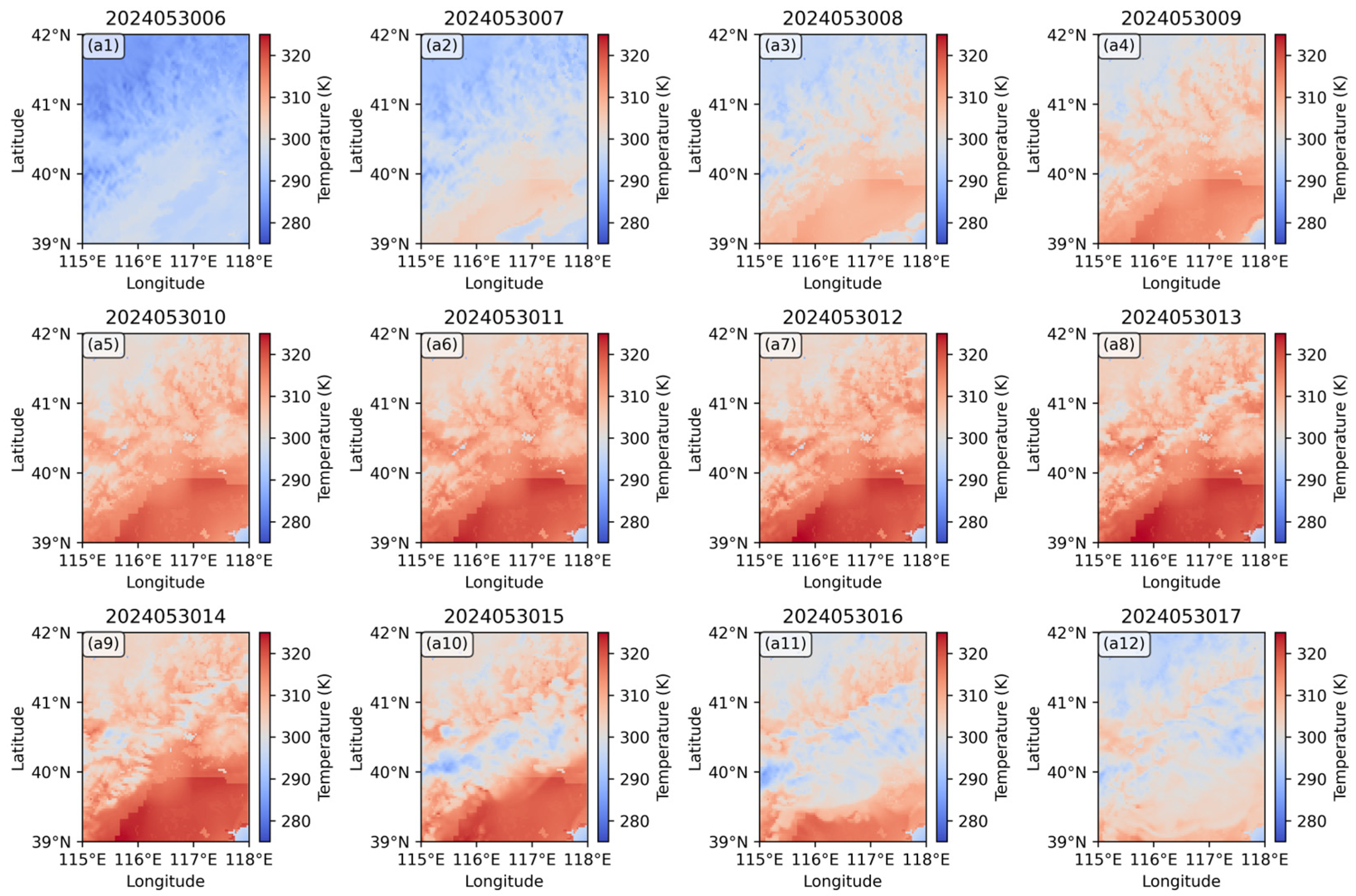
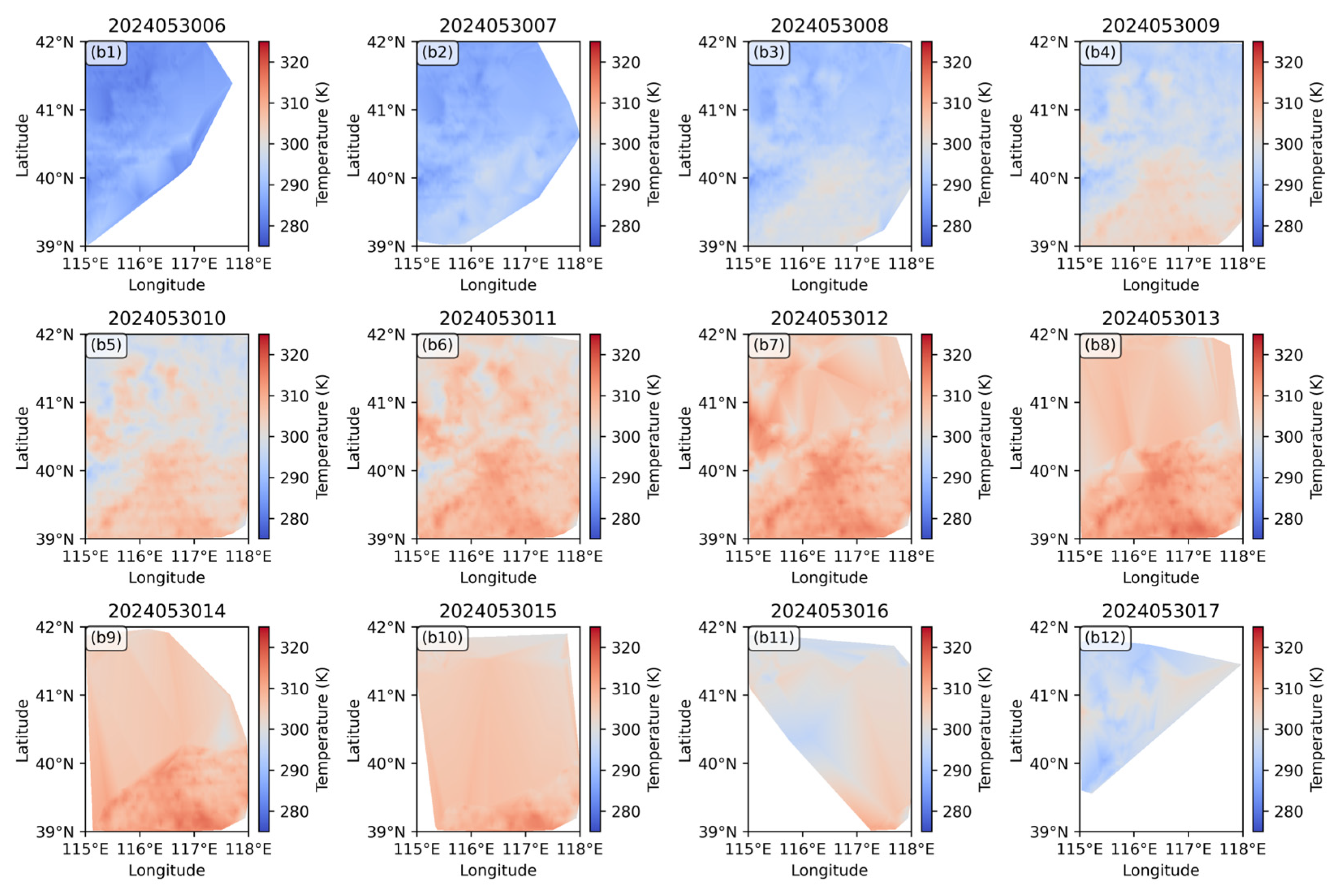
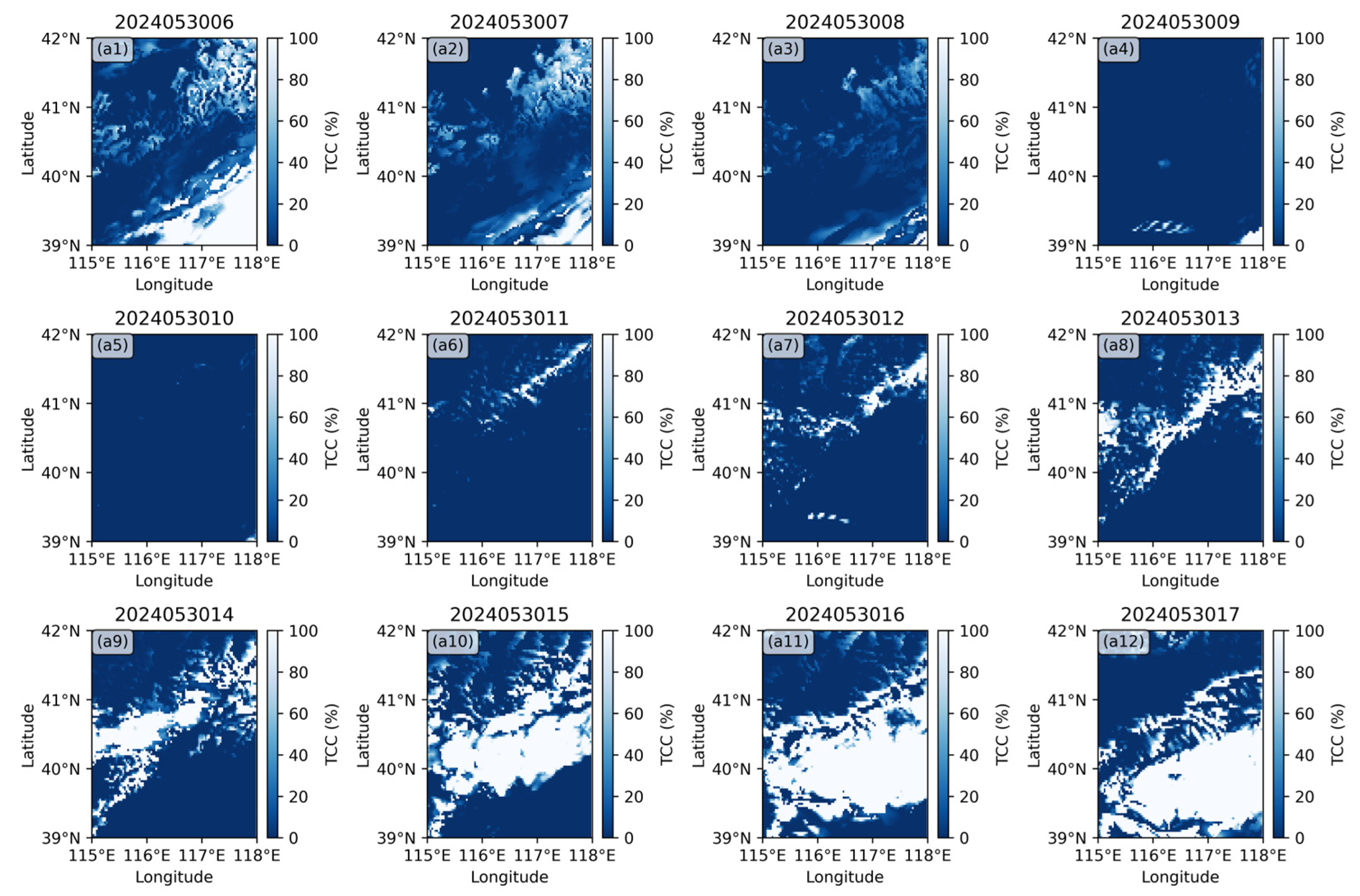

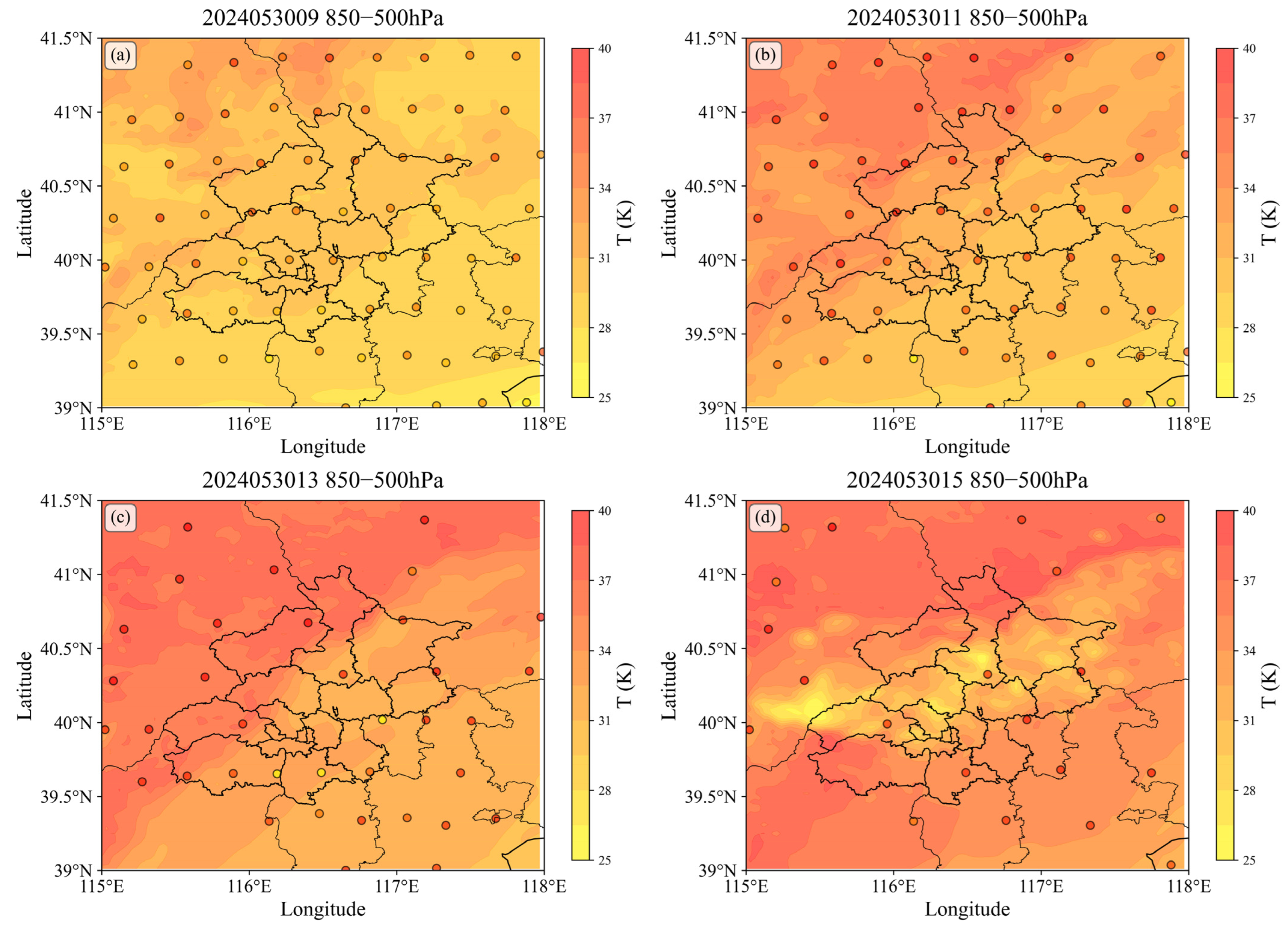


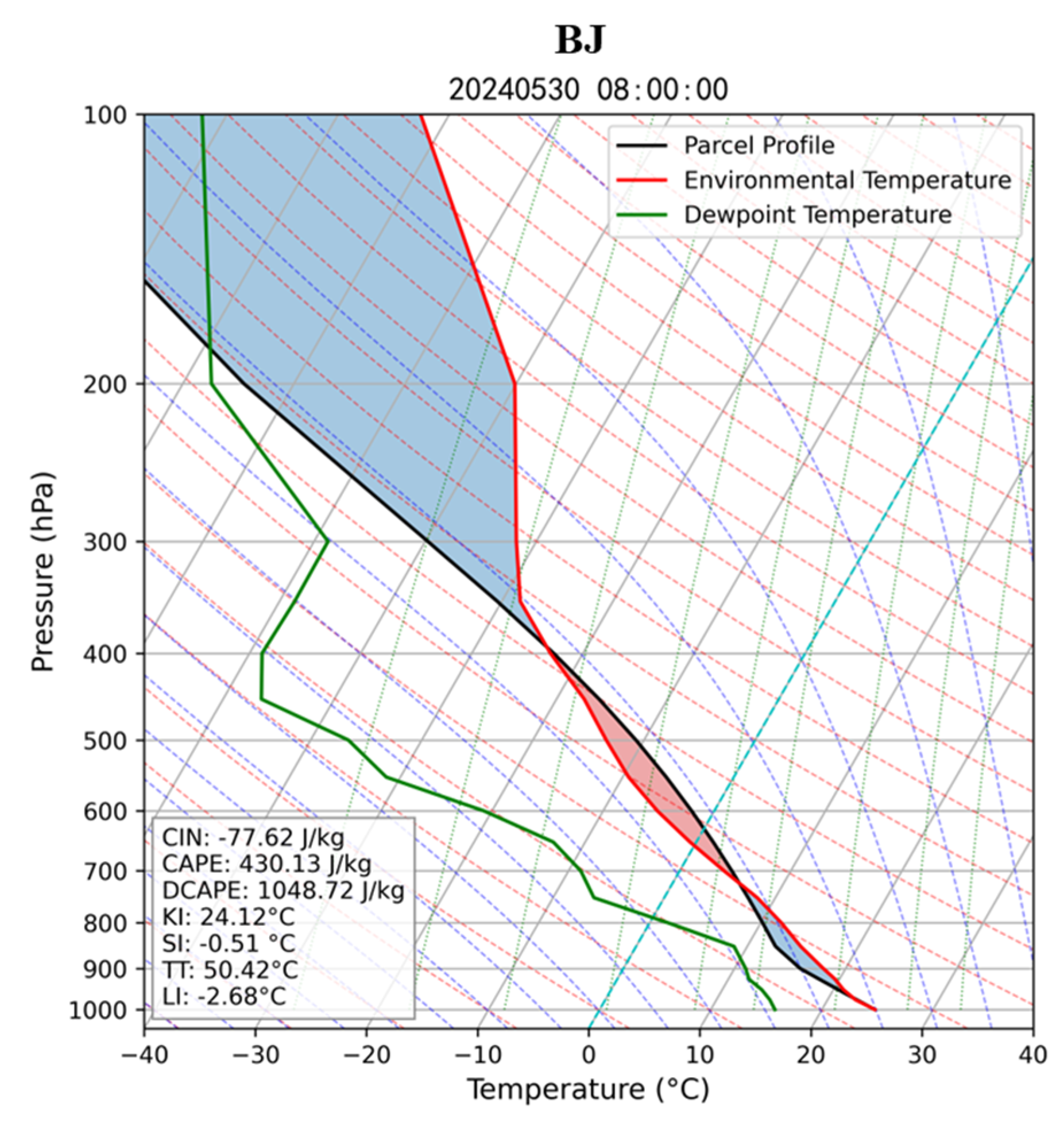
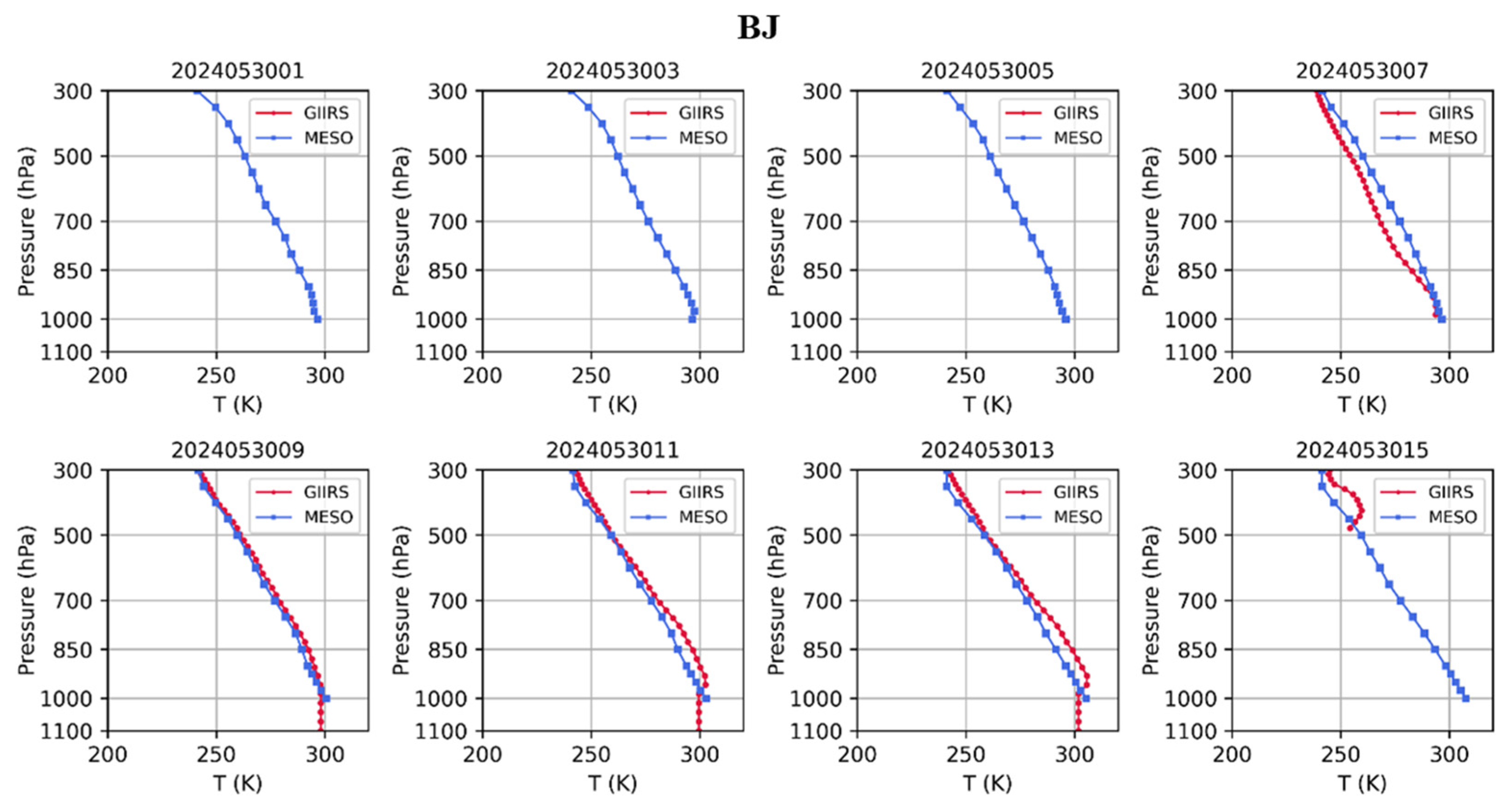
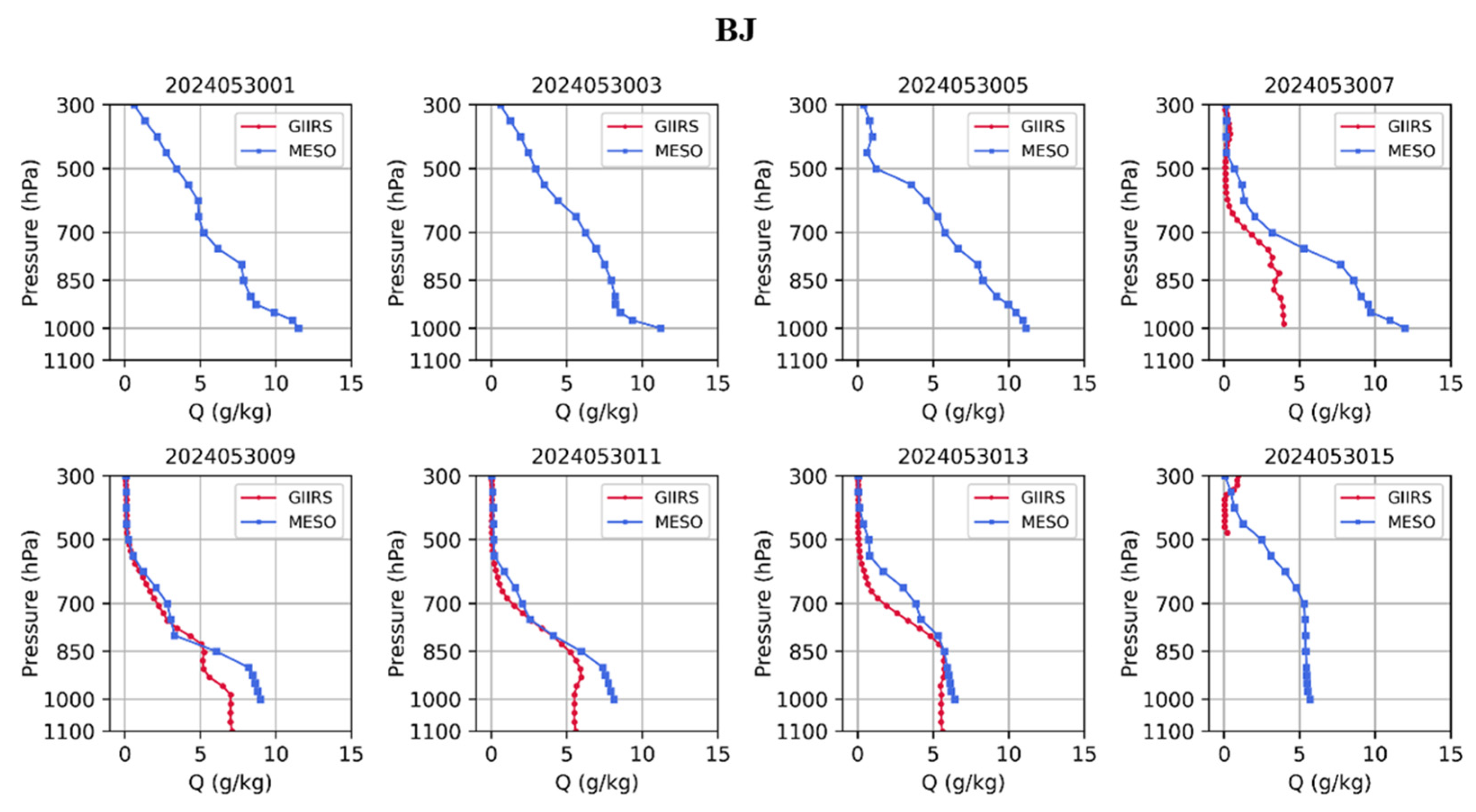
| Satellite Instrument/Product Category | Variable | Variable | Variable | Variable |
| AGRI/Surface Shortwave Radiation | Surface Solar Irradiance (SSI) | Surface Direct Solar Irradiance (DRS) | Surface Diffuse Solar Irradiance (DFS) | Surface Net Shortwave Radiation (NSR) |
| AGRI/Longwave Radiation | Upward Longwave Radiation (ULR) | Downward Longwave Radiation (DLR) | Outgoing Longwave Radiation (OLR) | |
| AGRI/Cloud | Cloud Coverage (CFR) | Cloud Top Height (CTH) | Cloud Phase (CLP) | |
| AGRI/Land Surface Temperature | Land Surface Temperature (LST) | |||
| GIIRS/Atmospheric Vertical Profiling | Atmospheric Temperature Profile (AT_Prof) | Atmospheric Humidity Profile (AQ_Prof) |
| Forecast Area | 10.0°N–60.01°N;70.0°E–145.0°E |
| Resolution | 0.03° (approximately 3 km)/50 layers |
| Observational Data | Conventional observations: sounding reports, ship reports, buoy reports, aircraft reports, surface reports (ps, u, v, RH, rain) Radar data: Doppler radar (reflectivity, radial wind, velocity-azimuth display wind) and wind profiler radar (u, v) data Satellite data: satellite cloud drift winds (FY-2G, HIMAWARI-8), Global Navigation Satellite System radio occultation, FY-4A imaging radiometer humidity meter(FY4-AGRI), FY2GTBB, FY2GCTA, Global Positioning System precipitable water |
| Physical Scheme | Shallow convection parameterization scheme WSM6 cloud microphysics scheme RRTM longwave radiation scheme Dudhia shortwave radiation scheme Monin–Obukhov near-surface-layer scheme Noah land surface model scheme New Medium-Range-Forecast boundary layer scheme |
| Variable (Unit) | Observation | Simulation |
|---|---|---|
| Convective available potential energy (J Kg−1) | 886.40 | 430.13 |
| Downdraft convective available potential energy (J Kg−1) | 1161.00 | 1048.72 |
| Convective inhibition (J Kg−1) | 0 | 77.62 |
Disclaimer/Publisher’s Note: The statements, opinions and data contained in all publications are solely those of the individual author(s) and contributor(s) and not of MDPI and/or the editor(s). MDPI and/or the editor(s) disclaim responsibility for any injury to people or property resulting from any ideas, methods, instructions or products referred to in the content. |
© 2025 by the authors. Licensee MDPI, Basel, Switzerland. This article is an open access article distributed under the terms and conditions of the Creative Commons Attribution (CC BY) license (https://creativecommons.org/licenses/by/4.0/).
Share and Cite
Xu, X.; Ni, Z.; Lu, Q.; Liu, R.; Wu, C.; Wang, F.; Hu, J. A Diagnostic Analysis of the 2024 Beijing May 30 Gale Simulation Based on Satellite Observation Products. Remote Sens. 2025, 17, 1378. https://doi.org/10.3390/rs17081378
Xu X, Ni Z, Lu Q, Liu R, Wu C, Wang F, Hu J. A Diagnostic Analysis of the 2024 Beijing May 30 Gale Simulation Based on Satellite Observation Products. Remote Sensing. 2025; 17(8):1378. https://doi.org/10.3390/rs17081378
Chicago/Turabian StyleXu, Xiaoying, Zhuoya Ni, Qifeng Lu, Ruixia Liu, Chunqiang Wu, Fu Wang, and Jianglin Hu. 2025. "A Diagnostic Analysis of the 2024 Beijing May 30 Gale Simulation Based on Satellite Observation Products" Remote Sensing 17, no. 8: 1378. https://doi.org/10.3390/rs17081378
APA StyleXu, X., Ni, Z., Lu, Q., Liu, R., Wu, C., Wang, F., & Hu, J. (2025). A Diagnostic Analysis of the 2024 Beijing May 30 Gale Simulation Based on Satellite Observation Products. Remote Sensing, 17(8), 1378. https://doi.org/10.3390/rs17081378








